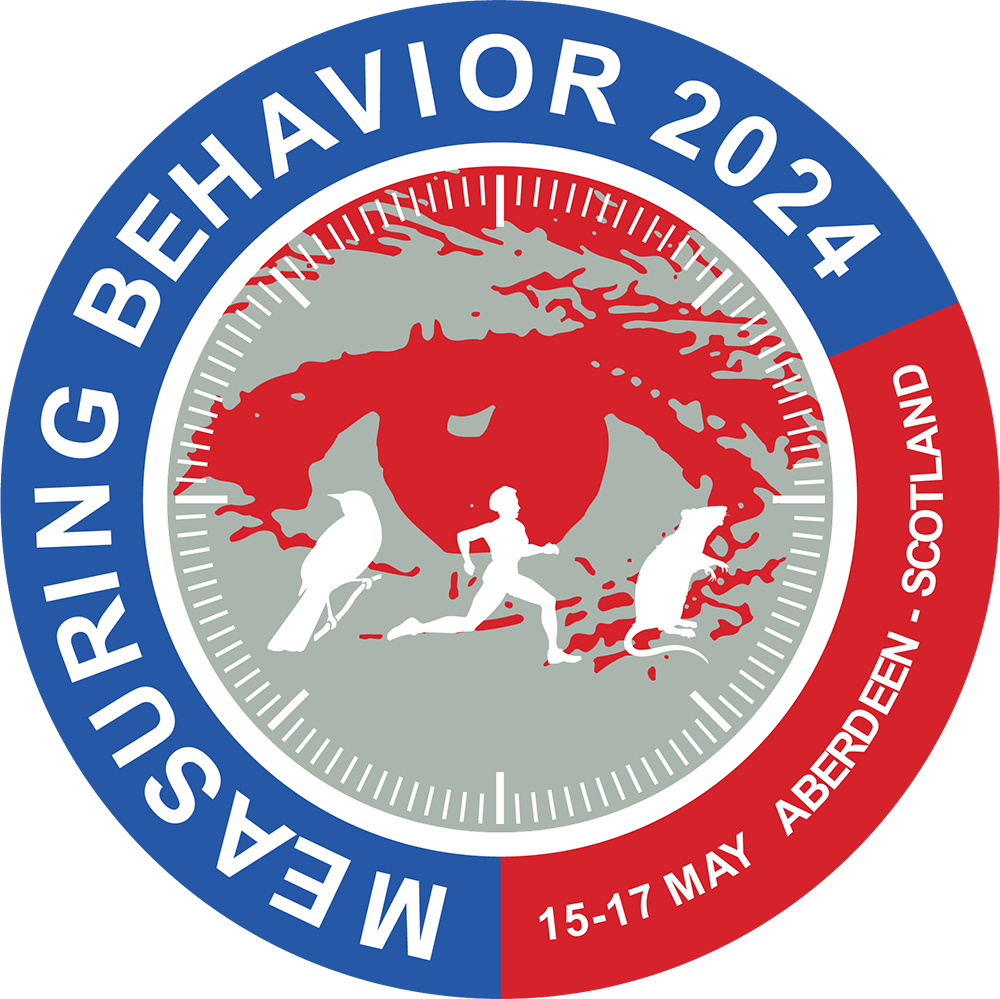Posters - Measuring Behavior
Abstracts for poster presentations have also been peer-reviewed in the same way as other presentations, and they will also be published in the Proceedings.
Poster session
There will be a poster session in which presentors can stand by their posters to answer questions on Thursday 16th May 14:00 – 15:00. That will be preceded (13:30 – 14:00) by a quick (maximum 1 min per poster) ‘flash’ presentation so that the delegates know what your poster is about. The posters will be on display for the entire conference in the same room as the refreshments and commercial exhibition. There will be a prize for the best poster.
Guidelines for poster presenters
Poster layout
We recommend posters of A0 size (841mm x 1189cm) in portrait orientation. An A1 size will fit in landscape orientation. The dimensions of the poster board are 954mm x 2360mm.
Make sure you clearly display the title of your poster, your name, your department or faculty and institution. In order to make poster accessible, please remember that the colours red with green or yellow with blue are difficult to read for some people.
A strong contrast between text colour and background should be used and multiple text colours should be avoided.
Images should include a descriptive caption.
Posters
The following posters will be presented:
- A Semi-automated Gait Assessment Tool for Mouse Locomotion Recovery after Neurological Injury
A. Bernstein, A. Vivinetto, J. Kaiser, M. Soliman, A. Lammers, V. Sahni1, and E. Hollis - Using a Pop-up Tunnel to Record Vocalisations of Sea Turtle Hatchlings to Avoid Geophony
S.N.D. Melo, D. A. Melo, M.F.S.D. Silva, V.C.S. Neves, B. Bezerra - The OpenBehavior Project: A Database and Dissemination Platform for Open-source Tools for Behavioral Neuroscience Research
S. Bradley, L. Amarante, K. Lopez, J. Frie, J. Palmer, S. White, J. Khokhar, A. Kravitz, and M. Laubach - Capturing Differences in Mouse Behaviour Induced by Gene Mutations and Pharmacological Intervention using Motion Sequencing
Jack Bray and Gernot Riedel - Micro-behavioral coding system for dynamic systems theory analysis of parent-child interactions in developmental disabilities
B. J. Byiers, J. Gunderson, C. Roberts, A. Dimian, and F. J. Symons - Deep Learning Behavioral Phenotyping System in the Diagnosis of Parkinson’s Disease with Drosophila melanogaster
Keyi Dong, April Burch and Kang Huang - Automated Recordings of Neural Activity in a Naturalistic Setting: the Drivemaze
C. Hartmann, H. Mansvelder and M. Karnani - Analyzing the Relationship between Selected Flight Parameters in the Saker Falcon (Falco cherrug)
T. Hegerová, A. Juráška and P. Juhás - Measuring Variability of Behavioral Traits, Rectal Temperature, and Heart Rate After Delivery in Holstein Cattle
P. Juhás, T. Hegerová - Modular Mouse Position Surveillance System (ModMoPSS) – a home-cage based test system for laboratory mice
P. Kahnau, B. Urmersbach, P. Mieske, K. Diederich, L. Lewejohann - The Neurological Impact of Room Temperature in Built Environment on Thermoregulate in Children with Autism
S. M. Kanakri - Development of a goal-directed behaviour protocol using the Barnes Maze
Ewa M. Kopeć, Lianne Robinson, Gernot Riedel - Assessing motivation and social communication in rodent: a challenge
C. Laloux - Assessment of emotional changes and pain in horses using infrared thermal measurement of the eye
Océane Liehrmann, Virpi Lummaa, Veera Riihonen, Léa Lansade - Using PLS-DA to discriminate facial expressions coded from EquiFACS in the study of affective experiences.
J. Lundblad and P. Haubro Andersen - Effects of acute sleep deprivation: A multimodal machine learning approach
S. Özsezen, L. Verschuren and A.M. Brouwer - Enhancing Cognitive Health in Older Adults through Combined Aerobic Exercise and Foreign Language Learning
Yijun Qian, Anna Schwartz, Yichi Zhang, Ara Jung, Gabi Wilds, Uri Seitz, Miso Kim, Arthur F Kramer, Leanne Chukoskie - Effect of Sampling rate and data source on rhythmicity computation
S. Rey, H.R Nasser and M. Cockburn - The aWISH project:Automated animal welfare monitoring for broilers and pigs at the slaughterhouse
T.B. Rodenburg, N. van Staaveren, M.F. Giersberg, N. Van Noten, K. van Langeveld, R. Klont, B. de Ruiter, M. Bouwknegt, B. Peijenburg, K. Mulder, F.A.M. Tuyttens - Contact-free Measurement of Behavioural Readouts in the Lizard Anolis carolinensis
N. Röhrdanz, A. Menon and P.Wulff - Rate and Patterns of Inter-Game Variability in Team Sports: Implications for Sample Size
Adam Sewell, Matthew T. Robins, Shelley A. Ellis and Andrew J. Callaway - Movement: a Python Toolbox for Analysing Pose Tracking Data
N. Sirmpilatze, C.H. Lo, B.D. Peri, D. Sharma, S. Miñano, S. Keshavarzi, A.L. Tyson - Unsupervised Machine Learning Analysis of Freezing Reveals Postures Correlating with Task Performance and Fear Level
Nancy J. Smith-Vickery, Daniel Weatherill, Andrew Wikenheiser, and Michael S. Fanselow - Failed Negative Geotaxis in Drosophila melanogaster: Measurement Techniques and Implications
J. Vasu, K. Vu, R. Hartman - CCK+ CA1 interneurons differentially contribute to hippocampus-dependent behaviour
K. Balueva, P. Wulff


At a Measuring Behavior meeting, you will find yourself among researchers from all fields of behavioral research: behavioral ecologists or neuroscientists, ethologists, developmental psychologists, ergonomists, human factors researchers, movement scientists, psychiatrists, psychophysiologists, toxicologists, usability testers, and others. While the research questions and applications may be highly diverse, what all delegates share is an interest in methods, techniques and tools for the study of behavior.
 Measuring Behavior
Measuring Behavior